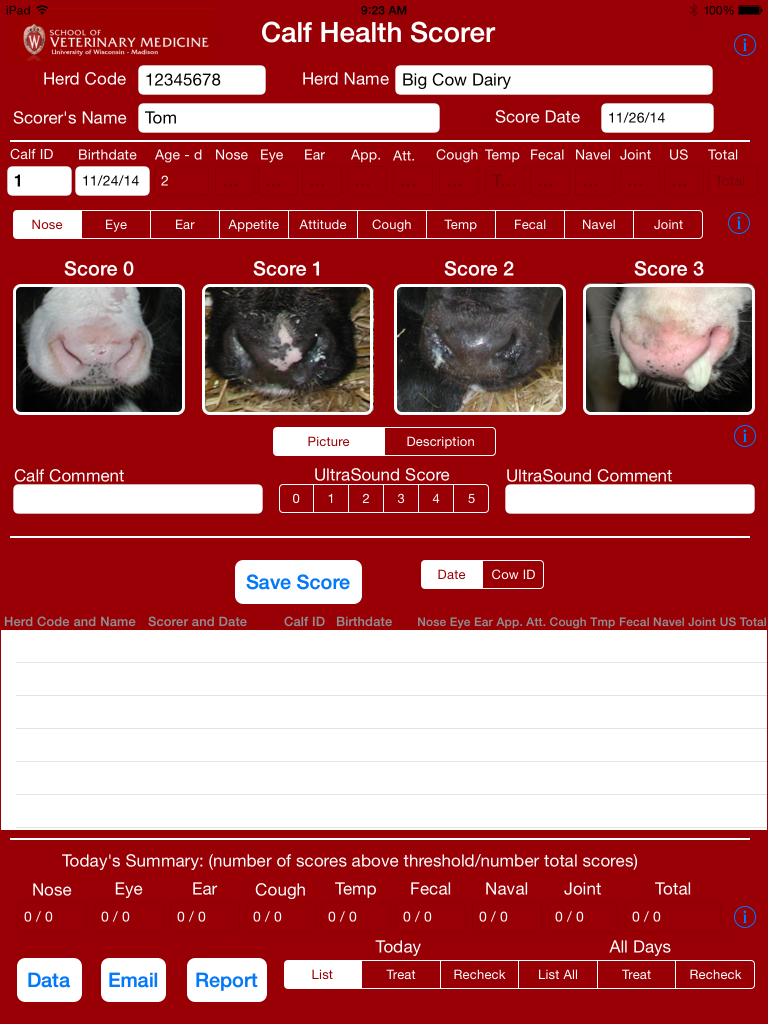Healthy Calf Conference
Follow to stay up-to-date on all Healthy Calf Conference updates. Speaker announcements, sponsorship information, registration announcements, and more.

Early diagnosis and treatment of disease in your calves can reduce the economic impact sickness and mortality have on your farm, while improving calf health and welfare. Catching disease sooner makes it easier to treat – requiring less medical care and antibiotics, as well as preventing a herd level outbreak and further complications. This leads to improved average daily gain. However, early disease detection can be challenging as some symptoms can be difficult to identify and monitor.
Two apps from the University of Wisconsin (UW) School of Veterinary Medicine aim to help producers make health scoring of their calves easier. Based on Dr. Sheila McGuirk’s “Calf Health Scoring” chart, the apps allow you to keep track of health parameters such as nasal discharge, ocular (eye) discharge, ear position/head carriage, appetite, attitude, coughing, rectal temperature, manure consistency, navel characteristics, and appearance of the joints. The apps provide a simple to use interface that displays photos and descriptions of health parameters so you can score each calf on a scale of 0 to 3, representing normal to very abnormal observations (see photo). If two or more parameters are moderately or severely abnormal (scores 2 or 3), disease is likely present, and the app will alert you. Find the scoring chart here.
The “Group Pen Respiratory Scorer” allows you to make observations at a pen level, and classify any high risk pens (a pen with more than 25 per cent of calves with two or more abnormal observations) and potentially sick animals. You can then score each animal in a high risk pen using the “Calf Health Scorer” to track disease progression. If you prefer, the “Calf Health Scorer” can be used independently of the “Group Pen Respiratory Scorer” to score each calf individually.
Calves should be health scored twice weekly. You can set aside a small amount of time daily to score a few pens or you can score your whole herd at once. Health scoring calves may be something you are already doing, but making it systematic and recording your observations will help you to catch illness sooner, identify patterns and keep track of treatments administered. Twice weekly health scoring should not replace daily observations – you should health score animals found to have abnormal observations more frequently, and you should record any abnormal findings as you see them.
Once you have completed the health scoring, you can review a report generated by the app, indicating which calves need to be treated and which calves were treated in the past. It is easy to send information about your herd’s health by email, making sharing important health records with your herd veterinarian a breeze.
Dr. Dave Renaud, Ph.D. candidate at the University of Guelph and bovine veterinarian at Main Street Animal Hospital in Cambridge, Ontario uses the app as part of his calf health research. He says, “The app is a really valuable tool that allows a standardized approach to identifying sick calves. When using the app, producers might be surprised that they may be able to identify sick calves sooner. Also, it is a great way to ensure everyone identifying sick calves on the farm is using the same approach so no sick calves are missed.”
You may see an initial increase in number of calves treated, treatment costs, respiratory illness, and calls to your herd veterinarian as sick calves are noticed earlier. However, early disease detection will reduce treatment costs, the number of calves given repeat treatments, sickness, and mortality over time. Further, you will be able to track performance, cost of production, disease incidence, and treatment efficacy to measure average daily gain and long term improvement in profitability. Those outcomes make health scoring worth the investment.
The “Group Pen Respiratory Scorer” and “Calf Health Scorer” apps are currently only available for iPad and cost $2.99 each. An Android version is currently in development.
Follow to stay up-to-date on all Healthy Calf Conference updates. Speaker announcements, sponsorship information, registration announcements, and more.
The Codes of Practice are nationally developed guidelines for the care and handling of farm animals. They serve as our national understanding of animal care requirements and recommended practices.